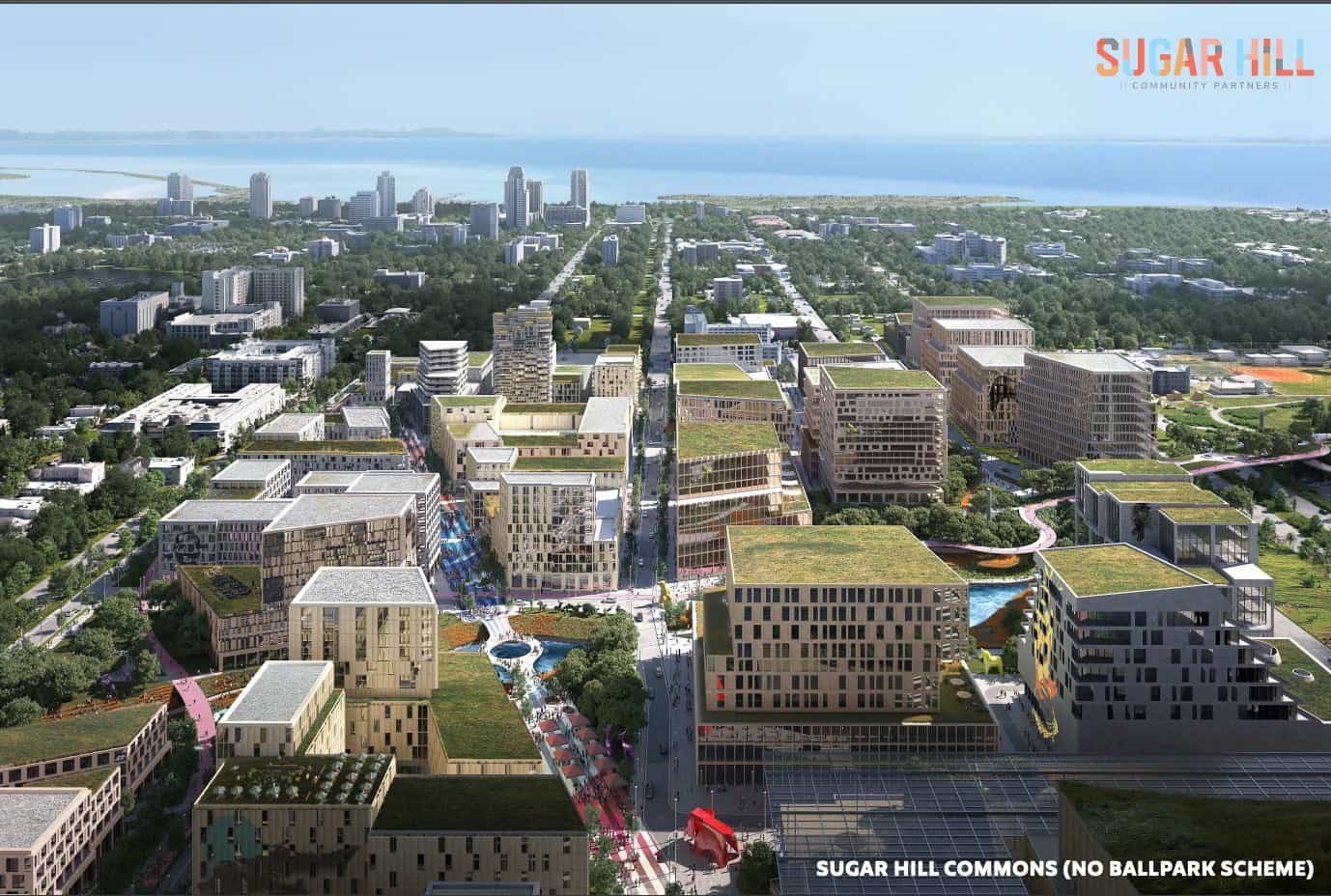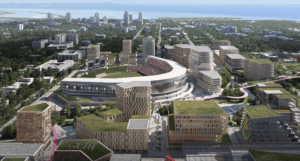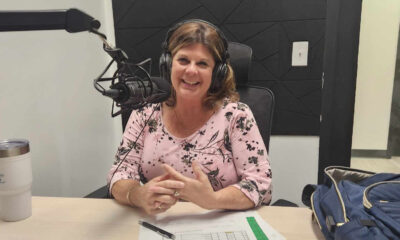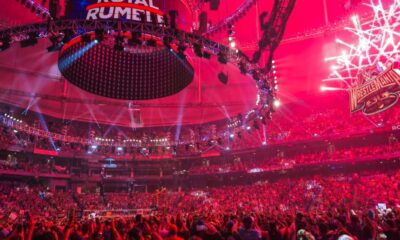Know
Inside baseball: Talking Trop with Sugar Hill

When then-St. Petersburg Mayor Rick Kriseman selected Midtown Development rather than Sugar Hill Community Partners to redevelop the 86-acre Tropicana Field site, Sugar Hill never dropped out of the race.
Sugar Hill Community Partners, a development team headed by San Francisco-based developer JMA Ventures and the Machete Group, kept its plans in motion with the hope that the newly elected mayor, Ken Welch, may ultimately select them as the master developer to turn the massive site into a vibrant neighborhood. Welch is expected to make his decision by June 30 for the site.
“We certainly knew that this was not over,” Dave Carlock, founder and President of the Machete Group, told the St. Pete Catalyst during an in-person interview this week, alongside his fellow team members.
“We kept working through it, and would still get together every week to talk about our response,” he said.

A rendering of what the Trop site could look like if Sugar Hill Community Partners is selected as the developer.
The team, similar to Midtown, is proposing to bring a wave of new office developments, residential complexes, restaurants and retail; however, it has put a large emphasis on the creation of a Community Equity Endowment (CEE), which would collect $30 million over the first 20 years and would be used to fund the construction of affordable single-family homes outside of the Trop site and provide grants.
“We wanted to create every opportunity possible for the community to feel truly connected and have a sense of ownership, and how equity should be equal across the board,” Carlock said.
The group was then introduced to Dan Tangherlini, Managing Director at Emerson Collective Investments LLC. Emerson Collective is a private philanthropic firm dedicated to removing barriers to opportunities, which was founded by Laurene Powell Jobs, the widow and heir of Apple Computer executive Steve Jobs.
“Dan and I were connected last fall, and he talked with me about this concept of a community endowment fund and walked us through it. Immediately, it made a lot of sense to us. On a high level, the challenge is if you’re going to create some type of economic interest in the community through development, how do you do that in such a way to include everyone without complex mechanics? And, without tax implications for people who may not be able to do that?” Carlock said. “This model cleaned up a lot of that and essentially, the idea is that the developer grants the community a profit interest in the project.”
The CEE will be instrumental in helping to fund the development by dividing a third, 33%, to fund affordable single-family home development for low-income areas in South St. Petersburg, outside of Tropicana Field. Habitat for Humanity of Pinellas and West Pasco Counties would receive a check through the CEE as it would serve as the builder for affordable housing.
Another third would go toward providing grants to small, minority-owned businesses, and the remaining 33% will be determined by the non-profit trustee.
The funding allocations distributed would be reported to provide transparency, and the developers would be excluded from the CEE.
“Our vision for the Trop is for someone teaching at an institution like NYU [New York University] studying design, to use this as a case study of how to build an inclusive urban redevelopment in the country,” Carlock said.
By the numbers: A highlight of Sugar Hill’s proposal
- The team has increased its initial number of affordable and workforce units by 1,416 (for a total of 2,401 units) in its Sugar Hill Parks scheme (with a Rays ballpark) and 1,550 (for a total of 3,165 units) in the Sugar Hill Commons scheme (without a Rays ballpark). Sugar Hill is in discussions with Liberty Bank, one of the largest Black-owned banks in the country, to act as a lender to affordable and workforce housing on the Trop.
- Based on several Covid-related factors, the team has adjusted the meeting venue program from a two-phase, 1.2-million-square-foot convention center to a 150,000-square-foot facility and a 500-key hotel.
- The team has committed to a 20% MBE goal across each phase of the project (design, construction and operations). There will also be a comprehensive mentoring program. As outlined in its original submission, it will build a workforce development program including a $2 million investment in a vocational skills academy. Sugar Hill will also fund a $5 million renovation of Campbell Park at the outset of the Trop development process and will donate $1 million to the African-American History Museum.
- Sugar Hill will develop a workforce pipeline to ensure that St. Pete residents are trained and ready for the jobs the Trop project will create.
It takes a village
“This is the largest, contiguous property in America poised for redevelopment that is in one of the greatest destinations [in my opinion], which is the only pedestrian-oriented destination in the state that is residential, retail and restaurant focused that connects every major neighborhood,” said Jordan Behar, principal of Behar Peteranecz Architecture, which has worked on several developments, including The Factory.
“It’s going to embrace the core values of what St. Pete is – it’s authentic, not disproportionately out of scale. The downtown has added close to 9 FARs (Floor Area Ratios), but you know when a project is too big for a property. We aren’t going for maximum density and let this become an urban jungle. We are going to make sure the scale, the character, the arts and culture are maintained, and the connective tissue with every other district is embraced,” he said.
Behar is part of the development team, which includes Santec as the civil engineering firm and DuCon Construction as the construction management firm.
Behar Peteranecz Architecture is also highly focused on creating a History Walk, a diagonal pedestrian artery connecting downtown St. Petersburg to South St. Petersburg. It would feature art from local African American artists.
“We can’t bring buildings back, but we can honor the people who built this community,” said Sarah-Jane Vatelot, who works as a project manager at Behar Peteranecz Architecture in the Warehouse Arts District, and has published work about the history of the site.
The group would also acknowledge its past by planting fruit trees, which once grew there.
The Sugar Hill team also would address Booker Creek, an underutilized natural amenity that often overflows. Santec, which has worked on restoration projects, would help redesign the creek to anchor a large park.
ADDITIONAL READING: Inside baseball: Talking Trop with Midtown Development








D S
June 23, 2022at4:20 pm
Affordable housing needs to be inside the development not outside as noted in Sugar Hill. The divide needs to go away! We want to bring the city together. There needs to be affordable housing throughout the city! Building affordable housing south and all other housing North will continue the divide!
Feels like that trend has already begun!
Erica Starr
June 23, 2022at4:02 pm
Talk about sore losers. $800 million required funding from the City.